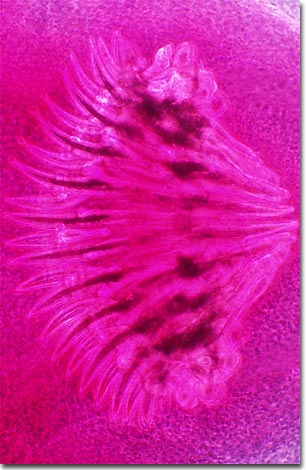Phase Contrast Image Gallery
Tapeworm (Taenia pisiformis)
Taenia pisiformis is one of several parasitic tapeworms that infect dogs, which are the definitive, or primary, host with rabbits most often serving as the intermediate host. Adult tapeworms live attached to the intestinal walls of their canine host. The life cycle stage that is found in the intermediate host is the cysticercus, or bladder worm, a larval form that lives encysted in muscle tissue.

The tapeworm has a simple anatomy, which is dedicated almost entirely to reproduction, but it can have a complex life cycle involving two or more hosts. The adult has a head (scolex) with suckers or hooks that are used to attach to the host. Tapeworms have a very simple nervous system and, lacking a digestive tract, absorb nutrients directly through an external layer of cuticle. Most species are hermaphroditic (containing both sexes) and can reproduce independently. During its lifetime, each tapeworm can produce hundreds of reproductive segments called proglottids, each of which can contain up to 40,000 larvae.
The proglottids pass through the digestive tract of the primary host and are eliminated with feces. Intermediate hosts, generally prey animals, ingest the larval forms when grazing on contaminated grass. Once ingested, the larvae emerge in the digestive tract where they burrow through the intestinal wall into a blood vessel and are carried to muscle tissue, in the case of Taenia pisiformis, or some other organ tissue. Various species of tapeworms select different tissues as destinations for the larvae.
When the infected muscle or organ of the intermediate host is eaten raw by a dog or canine, the cysticerci emerges and travel to the animal's intestine where it will attach and grow into the adult form. Tapeworms can also reproduce by shedding living segments that will grow into another tapeworm when ingested by another primary host.
BACK TO THE PHASE CONTRAST GALLERY
